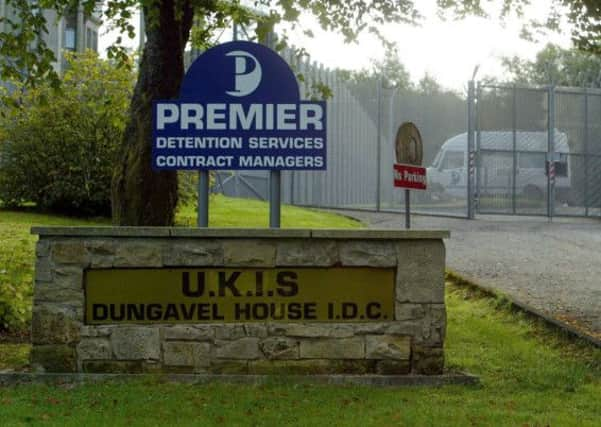Ebola: Dungavel detainee tests negative for virus


The woman, understood to have arrived from Sierra Leone, was being held at Dungavel Detention Centre in South Lanarkshire, but had been taken to hospital to undergo tests for the deadly infection which is affecting large parts of West Africa.
The Home Office had suspended the detention or release of detainees from Dungavel while the investigation was carried out and only staff or visitors were allowed in and out of the centre.
Advertisement
Hide AdAdvertisement
Hide AdNHS Lanarkshire said the tests were a precautionary measure and in a statement yesterday added that it was “highly unlikely” that the patient would have Ebola.
The latest negative test comes after two Sierra Leone athletes competing at the Commonwealth Games last month were also tested and found to be clear of the virus.
Background
Ebola is transmitted by direct contact with the body fluids of a person who is infected. So far more than 1,000 people have died and almost 2,000 suspected, probable or confirmed cases have been recorded in West Africa since the outbreak was first detected and the medical agency Médecins Sans Frontières (MSF) have warned it could take six months to get the spread of the disease under control.
Tarnue Karbbar, who works for the aid group Plan International in northern Liberia, said response teams were simply not able to document all the cases developing. Many of the sick were still being hidden at home by their relatives, too fearful of going to Ebola treatment centres.
Others were buried before the teams could get to the area, he said. In the past few days, some 75 cases have emerged in a single district.
“Our challenge now is to quarantine the area to successfully break the transmission,” he said, referring to the Voinjama district.
Gregory Hartl, a spokesman for the World Health Organisation in Geneva, said beds in treatment centres were filling up faster than they could be provided – evidence that the outbreak in West Africa is far more severe than the numbers show.
There were 40 beds at a treatment centre that MSF recently took over in one quarantined county in Liberia but 137 people have flocked there, packing the hallways until they can be separated into those who are infected and those are not, said MSF’s international president, Joanne Liu.
Advertisement
Hide AdAdvertisement
Hide Ad“It’s absolutely dangerous,” said Ms Liu, who recently returned from Guinea, Liberia and Sierra Leone.
“With the massive influx of patients that we had over the last few days, we’re not able to keep zones of patients anymore. Everybody is mixed,” she said.
The UN health agency warned that the official counts of 1,069 dead and 1,975 infected may still “vastly underestimate the magnitude of the outbreak”.
It said extraordinary measures were needed “on a massive scale to contain the outbreak in settings characterised by extreme poverty, dysfunctional health systems, a severe shortage of doctors, and rampant fear”.
Ebola causes a high fever, bleeding and vomiting. It has no cure and no licensed treatment, and has been fatal in at least 50 per cent of cases, experts said.
The disease is usually found in eastern or central Africa, typically in rural, isolated communities, where outbreaks tend to be “self-limiting”, Mr Hartl said.
By contrast, the current outbreak spread quickly to cities and the capitals of Guinea, Liberia and Sierra Leone, making it difficult to stop.